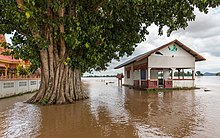User:Foxstronautilus/Climate risk insurance
| This is the sandbox page where you will draft your initial Wikipedia contribution.
If you're starting a new article, you can develop it here until it's ready to go live. If you're working on improvements to an existing article, copy only one section at a time of the article to this sandbox to work on, and be sure to use an edit summary linking to the article you copied from. Do not copy over the entire article. You can find additional instructions here. Remember to save your work regularly using the "Publish page" button. (It just means 'save'; it will still be in the sandbox.) You can add bold formatting to your additions to differentiate them from existing content. |
Article Draft
Lead
Climate risk insurance is a type of insurance designed to mitigate the financial and other risk associated with climate change, especially phenomena like extreme weather. The insurance is often treated as a type of insurance needed for improving the climate resilience of poor and developing communities[1]. It provides post-disaster liquidity for relief and reconstruction measures while also preparing for the future measures in order to reduce vulnerability. For low-income countries, these insurance programmes can be expensive due to the high start-up costs and infrastructure requirements for the data collection.[2]
Critics of the insurance, say that such insurance places the bulk of the economic burden on communities responsible for the least amount of
The international community invested in developing further support for this kind of insurance through the
Types of climate risk insurance
Flood insurance

The rising climate change related risks such as the sea level rise, floods and windstorms threaten the liveability and affordability of the impacted areas. [6] This is why one of the more widely used forms of climate risk insurance is flood insurance, which provides coverage against loss caused by flooding. [6] In the United States, the National Flood Insurance Program (NFIP) enables property owners to purchase government administrated insurance protections.
References
- )
- ^ )
- ^ a b Hermann, Alexandra (September 2016). "Climate Risk Insurance: New Approaches and Schemes" (PDF).
{{cite web}}: CS1 maint: url-status (link) - )
- ^ Kreft, Soenke (November 2017). "Climate Risk Insurance for Resilience: Assessing Countries' Implementation Plans" (PDF).
{{cite web}}: CS1 maint: url-status (link) - ^ )
